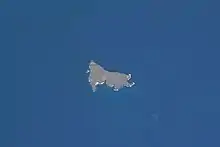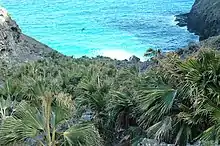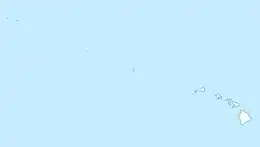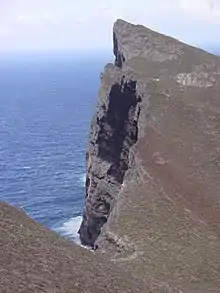 | |
 Nihoa | |
| Geography | |
|---|---|
| Location | Papahānaumokuākea Marine National Monument |
| Coordinates | 23°03′38″N 161°55′19″W / 23.06056°N 161.92194°W |
| Archipelago | Northwestern Hawaiian Islands |
| Area | 0.69 km2 (0.27 sq mi) |
| Administration | |
United States | |
| Demographics | |
| Demonym | Nihoan |
| Population | 0 |

Nihoa (/niːˈhoʊ.ə/; Hawaiian: Nīhoa [niːˈhowə] or Hawaiian: Nihoa [niˈhowə]), also known as Bird Island or Moku Manu, is the tallest of ten islands and atolls in the uninhabited Northwestern Hawaiian Islands (NWHI). The island is located at the southern end of the NWHI chain, 296 km (160 nmi) southeast of Necker Island. Nihoa is the closest NWHI in proximity to the eight main windward Hawaiian Islands at approximately 240 km (130 nmi) northwest of the island of Kauaʻi. The island has two peaks, 272 m (892 ft) Miller's Peak in the west, and 259 m (850 ft) Tanager Peak in the east. Nihoa's area is about 171 acres (0.69 km2) and is surrounded by a 142,000-acre (57,000 ha) coral reef. Its jagged outline gives the island its name, Nīhoa, which is Hawaiian for "toothed, serrated".[1]
The island is home to 25 species of plants and several animals, making it the most diverse island in the entire NWHI. Endemic birds like the Nihoa finch and Nihoa millerbird, and endemic plants like Pritchardia remota and Schiedea verticillata are found only on Nihoa. Amaranthus brownii was considered the rarest plant on Nihoa and has not been directly observed on the island since 1983, and is now considered to be extinct. The plant communities and rocky outcrops provide nesting and perching areas for 18 species of seabirds, such as red-footed boobies and brown noddies, terns, shearwaters, and petrels. Prehistoric evidence indicates Native Hawaiians lived on or visited the island around AD 1000, but over time the location of Nihoa was mostly forgotten, with only an oral legend preserving its name. Captain James Colnett rediscovered the island in 1788, and Queen Kaʻahumanu visited it in 1822. It was made part of the Kingdom of Hawaii by King Kamehameha IV.
In 1909, Nihoa became part of the Hawaiian Islands Reservation, a federal wildlife refuge established by U.S. President Theodore Roosevelt. The Tanager Expedition surveyed the island in 1923, taking a comprehensive biological inventory of its many species. In 1940, it became part of the Northwestern Hawaiian Islands Wildlife Refuge and in 1988, it was listed on the National Register of Historic Places due to its culturally significant archaeological sites. In 2006, it became part of the Papahānaumokuākea Marine National Monument. Efforts are underway to ensure that endangered plant species are propagated beyond their limited range and represented in ex situ collections. Persons intending to visit Nihoa for cultural and scientific research purposes require a USFWS-issued special-use permit to land on the island so as to reduce the risk of introducing alien species to Nihoa's already fragile ecosystem.
Geology and geography

Nihoa is part of the Hawaiian – Emperor seamount chain of volcanic islands, atolls, and seamounts starting from the island of Hawaiʻi in the southeast to the Aleutian Islands in the northwest. It is the youngest of ten islands in the uninhabited Northwestern Hawaiian Islands (NWHI), having formed 7.2 million years ago; the oldest, Kure Atoll, formed 30 million years ago. Over the millennia, Nihoa has experienced significant erosion; along with Necker, French Frigate Shoals, and Gardner Pinnacles, Nihoa is one of only four islands in the NWHI that still has an exposed basalt rock substrate.[2] Six valleys slant down from north to south, meeting at the south side of the island: West Valley, West Palm Valley, Miller Valley, Middle Valley, East Palm Valley, and East Valley.
The valleys slant towards Adam's bay on the south side, which also has sea cave.[3]
Among features on Nihoa are Dog's Head Peak (358 ft or 109 m), named for its likeness, and Pinnacle Peak (626 ft or 191 m), a volcanic dike created when less resilient rock was eroded away and harder rock was open to the elements. The only flat area on the island is Albatross Plateau, just below Miller's Peak. The Devil's Slide is a narrow cleft descending 700 feet (210 m) irrespective of the surrounding elevation. Extending northward from Albatross Plateau, it ends at the vertical cliffs with a 190-foot (60 m) drop straight down to the ocean below. In this chasm, rare ferns grow, along with several endemic species, including a giant cricket.[4]
The island is about 1371 meters long going from east to west, and 274–914 meters wide.[3] The overall shape is that of half saddle, with one side having sheer cliffs and the other sloping towards the ocean.[3][5]
The highest peaks on the island include Miller peak at 277 meters high and Tanager peak at 260 m. high.[3]
Ecology


Nihoa's inaccessibility and lack of major guano deposits made the island unattractive to humans, helping to preserve its endemic species from extinction. Because of Nihoa's small size, most of its endemic organisms are endangered, as one single disaster such as an island-wide fire or an introduction of invasive species could wipe out the whole population. One such invasive species is the gray bird grasshopper, Schistocerca nitens; from the period between 1999 and 2003, grasshoppers devastated much of the vegetation on the island and posed a real threat to the continued health of plants on Nihoa.[6] The following year, the numbers decreased and the vegetation became lush again. The grasshoppers probably came to Nihoa by way of wind from Kauai.
The north side of the island's cliffs are mostly bare, but the sloping valleys are covered with a variety of grasses and shrubs.[3] The two most common grasses on these slopes are Eragrosis Varabilis and Panicum torridum.[3]
There is also a variety of scrubs and bushes on the island slopes, such as Chenopodium sandwicheum and ilima bushes (Sida fallax).[3]
Unique species include:
- Pritchardia remota fan palm, the only tree on the island
- Nihoa millerbird
- Nihoa finch
- Nihoa conehead katydid
- Nihoa carnation
- Sesbania tomentosa
- the amaranth Amaranthus brownii
- the trapdoor spider Nihoa mahina
- Thaumatogryllus conanti, a giant cricket found in the Devil's Slide area
- Plagithmysus nihoae, a longhorned beetle
- Eupelmus nihoaensis, a wasp
- Hylaeus perkinsianus, Perkin's yellow-faced bee
Important Bird Area
The island forms part of the Northwest Hawaiian Islands Important Bird Area (IBA), designated as such by BirdLife International because of its seabirds and endemic landbirds.[7]
Ancient history
Nihoa Island Archeological District | |
 View of Nihoa Island | |
 | |
| Nearest city | Kauai, Hawaii |
|---|---|
| NRHP reference No. | 88000640[8] |
| Added to NRHP | June 13, 1988 |
Nihoa was well known to the early Hawaiians. Archaeological expeditions found extensive prehistoric agricultural terraces and house sites.[9] At least one site has been dated to around the 1st millennium AD, sometime between 867 and 1037.[10] There is some doubt as to the number of people that lived on Nihoa, because while the large terraces suggest a considerable number, there is scant fresh water to be found. Archaeologists Kenneth Emory[11] and Paul Cleghorn[12] estimate that water could support as many as 100 people, although if the island were previously forested, this would have increased fresh water supplies relative to its current state. Because of the island's importance, the island was added to the National Register of Historic Places in 1988, and subsequently became part of Papahānaumokuākea Marine National Monument in June 2006.
Nihoa, along with Necker Island to the northwest, is among the most northern, isolated, smallest and driest of the high volcanic Hawaiian islands, and receives the lowest dust and tephra input. All of these features were found to strongly predict deforestation among the Pacific Islands. The abandonment of Nihoa may be tied to deforestation although this has not been proven and small groves of trees were noted in the major drainage valleys during survey work conducted in 1928.[11]
Artifacts recorded on the island represent a unique material culture demonstrating restraint in the utilization of wood. A number of artifact types such as bowls and human figures called ki'i that elsewhere in the Hawaiian chain would have been made out of wood were instead carved from stone, a lengthy and labor-intensive process.[13] Archaeological sites on the island are similar to other site types within the Hawaiian islands and include both packed dirt and stone terraces likely for habitation and agricultural uses on the steep slopes of the island, cave shelters, and heiau. Some scholars consider Nihoa to be a matched pair with Necker Island although the latter appears not to have had a permanent population.[13]
The heiau on Nihoa and Necker Islands are unique in the Hawaiian chain representing a raised pavement of basalt stones with upright stones placed across this pavement often near the edges[11] as opposed to the form common to other islands in the chain represented by a high stacked stone wall enclosing a central space. This difference in form represents an earlier iteration of Hawaiian monumental architecture that offers a unique perspective on cultural norms prior to the abandonment of Nihoa.[14] Thanks to this difference in form, scholars often use the term 'marae' as opposed to 'heiau' in reference to these structures and some scholars argue that the shift in form represents a shift in ritual practice in Hawaii.[15]
Early exploration
.jpg.webp)
The first Westerner to discover Nihoa was Captain James Colnett of the Prince of Wales, on March 21, 1788. Due to Colnett's lengthy absence from England, including his imprisonment by the Spanish for his part in the Nootka Sound Incident, the discovery was once widely accredited to Captain William Douglas of the Iphigenia, who sighted Nihoa almost a year later.[16]
The abandoned settlements seen by the early explorers caused Nihoa and Necker islands, to be called the 'mystery islands'.[13] However, this term is used more generally to refer to any island in the Pacific that was similarly abandoned prior to European contact.
By the end of the 18th century, Nihoa had been forgotten by most Hawaiians. In 1822, Queen Kaʻahumanu and her husband King Kaumualiʻi traveled with Captain William Sumner to find Nihoa, as her generation had only known the island through songs and myths.[9] Later, King Kamehameha IV sailed there to officially annex the island as part of the Kingdom of Hawaiʻi. Finally, in 1885, Princess Liliuokalani made a pilgrimage to Nihoa with her escorts, but their luncheon was cut short when one of the party ignited a wildfire by accident. The group tried to flee the island, but the rising tides made it difficult and several boats were flooded, destroying some of the photographs taken.[17] On this visit a carved basalt bowl was found and taken back to the main islands by the Queen.[13]
In 1859 the position of Nihoa island was determined by the survey schooner, USS Fenimore Cooper.[3]
Tanager expedition

During 1923-4 the Tanager expedition was a noted scientific exploration of Nihoa island.[18] This resulted in various biological and archeological discoveries.[19][20]
The Tanager expedition conducted the first archeological survey of the island.[3] Evidence of an ancient settlement on Nihoa was discovered, along with platforms, terraces, and human remains.[19]
Noted events include finding a specimen of Amaranthus brownii and the discovery of the Nihoa millerbird which was formally named Acrocephalus familiaris kingi,[20]
On this expedition, several hundred Loulu fan palms were counted on the island.[3] Twenty other flowering plants were also noted at this time.[3]
Examples of exploration work:[3]
- Survey map of island
- Bird life
- Plants
- Insects
- Marine life
- Geology
On the Tanager expedition they also found the remnants of a modern Fishing camp in a cave near the landing, with some leftover coats and bags of rice.[3]
See also
Notes
- ↑ Pukui, Mary; Elbert, Samuel, eds. (2003), ""nihoa" entry", Hawaiian Dictionary, University of Hawaiʻi Press,
Pas[sive]/imp[erative]. of niho; toothed, serrated, notched, jagged, sharp...
- ↑ Department of Forestry and Wildlife (2005). "Chapter 6: Northwestern Hawaiian Islands. Hawaii's Comprehensive Wildlife Conservation Strategy (CWCS)" (PDF). Hawai'i Department of Land and Natural Resources. Archived from the original (PDF) on March 22, 2012.
- 1 2 3 4 5 6 7 8 9 10 11 12 13 The Northwestern Hawaiian Islands: An Annotated Bibliography. U.S. Fish and Wildlife Service. 1978. Retrieved March 25, 2021.
- ↑ Rauzon 2001.
- ↑ Rauzon 2001, p. 8. Captain William Douglas, the second Western explorer to find Nihoa, describes the island as "[bearing] the form of a saddle, high at each end, and low in the middle. To the south, it is covered with verdure; but on the north, west, and east sides it is a barren rock, perpendicularly steep..."
- ↑ Liittschwager & Middleton 2005, p. 94
- ↑ "Northwestern Hawaiian Islands)". BirdLife Data Zone. BirdLife International. 2020. Retrieved December 16, 2020.
- ↑ "National Register Information System". National Register of Historic Places. National Park Service. January 23, 2007.
- 1 2 Tava & Keale 1998, pp. 102–103.
- ↑ Hunt, Terry L.; Holsen, Robert M. (1991). "An Early Radiocarbon Chronology for the Hawaiian Islands: A Preliminary Analysis". Asian Perspectives. 30 (1): 157. hdl:10125/19261. ISSN 0066-8435.
- 1 2 3 Emory, Kenneth P. (2003) [1928]. Archaeology of Nihoa and Necker Islands. Bishop Museum Bulletin. 53. Bishop Museum Press.
- ↑ Cleghorn, Paul L. (1988). "The settlement and abandonment of two Hawaiian outposts: Nihoa and Necker islands". Bishop Museum Occasional Papers. Bernice Pauahi Bishop Museum. 28: 35–49.
- 1 2 3 4 Archeology of the “Mystery Islands” Nihoa and Mokumanamana
- ↑ Kirch, Patrick Vinton (1985). Feathered gods and fishhooks: an introduction to Hawaiian archaeology and prehistory. Honolulu: University of Hawaii Press. ISBN 0-8248-0981-5. OCLC 11841243.
- ↑ Kirch, Patrick Vinton (2019). Heiau, ʻaina, lani : the Hawaiian temple system in ancient Kahikinui and Kaupō, Maui. C. L. N. Ruggles, Andrew B. Smith. Honolulu. ISBN 978-0-8248-7942-6. OCLC 1099790638.
{{cite book}}: CS1 maint: location missing publisher (link) - ↑ Rauzon 2001, p. 8.
- ↑ Rauzon 2001, p. 12.
- ↑ "Nihoa Island - Hawaiian Islands". www.fws.gov. U.S. Fish and Wildlife Service. Retrieved March 25, 2021.
- 1 2 Emory 1928
- 1 2 Rauzon 2001, p.18
References
- Conant, Sheila (1985). "Recent Observations on the Plants of Nihoa Island, Northwestern Hawaiian Islands". Pacific Science. University of Hawaii Press. 39 (2): 135–149. hdl:10125/921.
- Evenhuis, Neal L.; Eldredge, Lucius G., eds. (2004). Natural History of Nihoa and Necker Islands. Bishop Museum Bulletin in Cultural and Environmental Studies; No. 1. Honolulu, Hawaii: Bishop Museum Press. ISBN 1-58178-029-X.
- Emory, Kenneth P. (2002) [1928]. Archaeology of Nihoa & Necker Islands. Mutual Publishing. ISBN 1-56647-565-1.
- Liittschwager, David; Middleton, Susan (2005). Archipelago: Portraits of Life in the World's Most Remote Sanctuary. National Geographic. ISBN 0-7922-4188-6.
- MacDonald, Gordon A.; Peterson, Frank L.; Abbott, Agatin T. (1983). Volcanoes in the Sea: Geology of Hawaii (2nd ed.). University of Hawaii Press. ISBN 0-8248-0832-0.
- Tava, Rerioterai; Keale, Moses K. (1998). Niihau, the traditions of a Hawaiian island. Mutual Publishing. ISBN 0-935180-80-X. Archived from the original on May 24, 2013.
- Rauzon, Mark J. (2001). Isles of Refuge: Wildlife and History of the Northwestern Hawaiian Islands. University of Hawaii Press. p. 12. ISBN 0-8248-2330-3.
- United States Census Bureau. Nihoa Island: Block 1000, Census Tract 114.98, Honolulu County, Hawaii
Further reading
- Beardsley, John W. (1966). "Insects and other terrestrial arthropods from the leeward Hawaiian Islands". Proc Hawaiian Entomol Soc. 19: 157–185. hdl:10125/10915. ISSN 0073-134X.
- Clapp, Roger B.; Eugene Krindler; Robert R. Fleet (May 1977). F. R. Fosberg; M. -H. Sachet; D. R. Stoddart (eds.). "The Natural History of Nihoa Island, Northwestern Hawaiian Islands" (PDF). Atoll Research Bulletin. Washington, D. C.: Smithsonian Institution (207). Archived from the original (PDF) on September 13, 2006. Retrieved December 7, 2008.
- Cleghorn, Paul L. (1987). Prehistoric Cultural Resources and Management Plan for Nihoa and Necker Islands, Hawaiʻi. Honolulu: Bishop Museum Press.
- Gagné, Wayne C.; Sheila Conant (1983). "Nihoa: Biological Gem of the Northwest Hawaiian Islands". Bishop Museum News. Bernice P. Bishop Museum (7): 3–5.
- Hawai'i Department of Land and Natural Resources (2008). "Papahanaumokuakea Marine National Monument Management Plan: Appendix A - Cultural Impact Assessment" (PDF). Volume II: Final Environmental Assessment. U.S. Fish and Wildlife Service. Archived from the original (PDF) on May 15, 2009. Retrieved September 30, 2009.
- Juvik, Sonia P.; James O. Juvik; Thomas R. Paradise (1998). Atlas of Hawaii. University of Hawaii Press. ISBN 978-0-8248-2125-8.
- Kirch, Patrick Vinton (1985). Feathered Gods and Fishhooks: An Introduction to Hawaiian Archaeology and Prehistory. University of Hawaii Press. ISBN 9780824819385.
- Lebo, Susan A.; Kevin T.M. Johnson (2007). "Geochemical sourcing of rock specimens and stone artifacts from Nihoa and Necker Islands, Hawiʻi". Journal of Archaeological Science. Elsevier. 34 (6): 858–871. doi:10.1016/j.jas.2006.08.009.
- Olson, Storrs L. (1996). "History and ornithological journals of the Tanager Expedition of 1923 to the northwestern Hawaiian Islands, Johnston and Wake islands". Atoll Research Bulletin. National Museum of Natural History. 433 (433): 1–210. doi:10.5479/si.00775630.433.1.
- Palmer, H. S. (1927). "Geology of Kaula, Nihoa, Necker and Gardner Islands, and French Frigate Shoals". Bernice P. Bishop Museum Bulletin. Tanager Expedition Publication Number 4. 35.
- Wong, Sterling (2008). "Nihoa". Ka Wai Ola. Office of Hawaiian Affairs. 25 (11): 12.


.svg.png.webp)